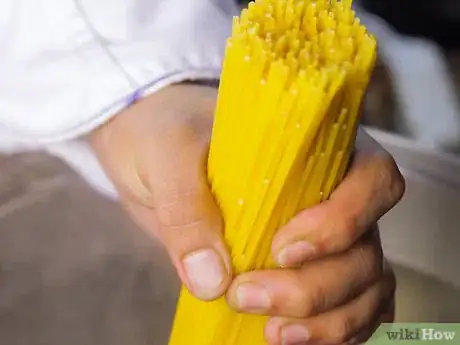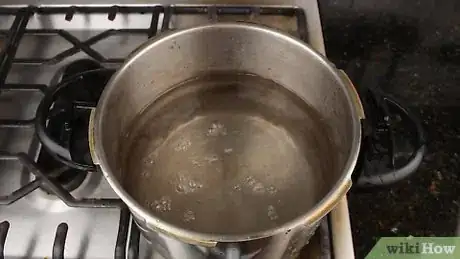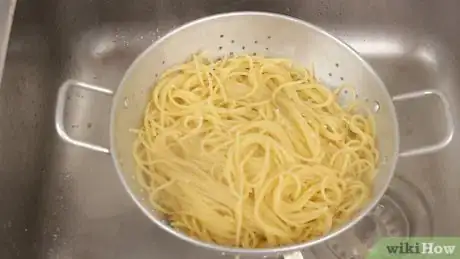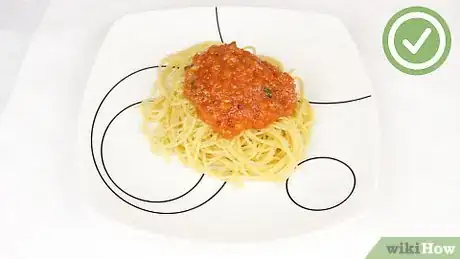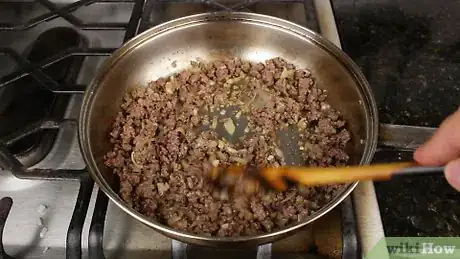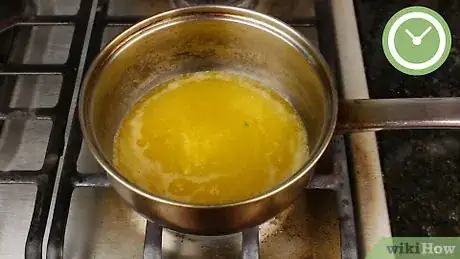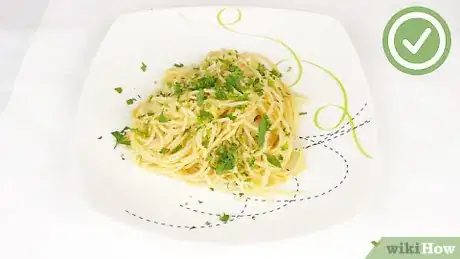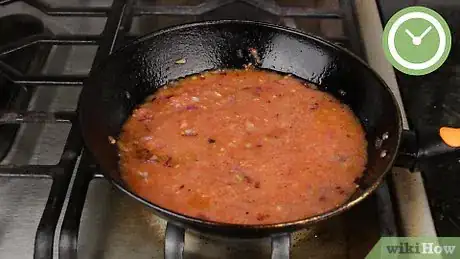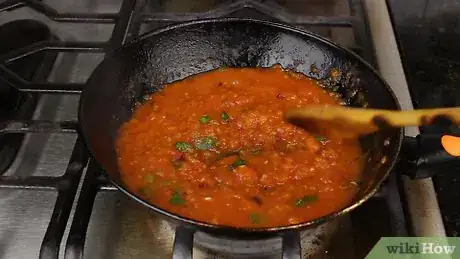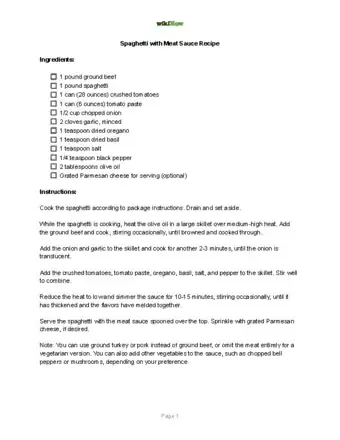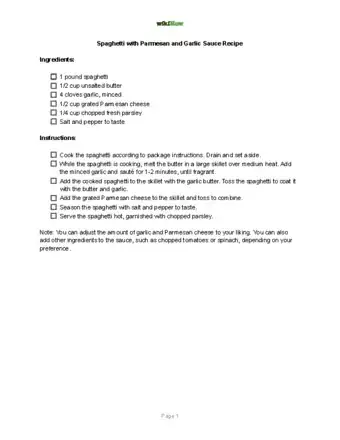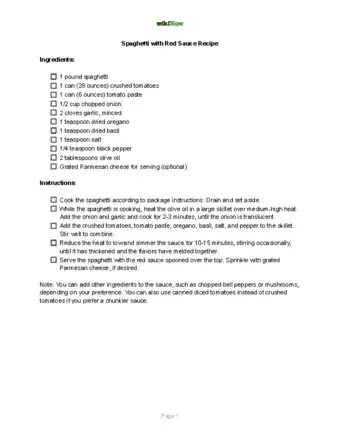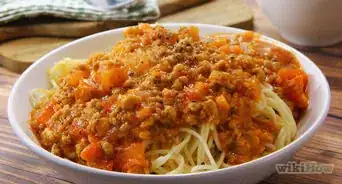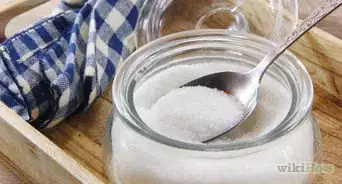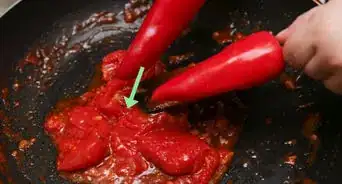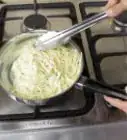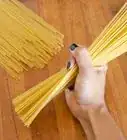This article was co-authored by wikiHow staff writer, Jessica Gibson. Jessica Gibson is a Writer and Editor who's been with wikiHow since 2014. After completing a year of art studies at the Emily Carr University in Vancouver, she graduated from Columbia College with a BA in History. Jessica also completed an MA in History from The University of Oregon in 2013.
The wikiHow Culinary Team also followed the article's instructions and verified that they work.
This article has been viewed 1,567,674 times.
Learn more...
Spaghetti makes a great inexpensive meal that cooks up fast. In the time it takes to cook the noodles, you can make a number of sauces. If you're in a hurry, quickly brown your choice of ground meat and then briefly simmer it with a jar of your favorite pasta sauce. For a non-red sauce option, toss the noodles with browned butter, garlic, and Parmesan. If you have the time to make a homemade red sauce, sauté red onion with tomatoes, garlic, and basil.
Ingredients
- 8 to 16 ounces (446 to 892 g) dry spaghetti noodles
- Water
- 1 to 2 tablespoons (17 to 34 g) kosher salt
Makes 4 to 8 servings
- 12 ounces (670 g) spaghetti, cooked and drained
- 2 tablespoons (30 ml) canola or vegetable oil
- 1 onion, chopped
- 2 tablespoons garlic, minced
- 1 24-ounce (680 g) jar or can of red pasta sauce
- 1 pound (0.45 kg) ground meat such as beef, turkey, pork, or chicken
- Salt and pepper to taste
- Grated Parmesan cheese, optional
Makes 4 to 6 servings
- 8 ounces (446 g) spaghetti, cooked and drained
- 10 tablespoons (140 g) unsalted butter
- 3 cloves garlic, minced
- 1 teaspoon (2 g) crushed red pepper flakes, optional
- 1/2 cup (50 g) freshly grated Parmesan cheese
- Kosher salt and freshly ground black pepper, to taste
- 2 tablespoons (7.6 g) fresh parsley leaves, chopped
Makes 2 to 3 servings
- 12 ounces (670 g) spaghetti, cooked and drained
- 1 28-ounce (784 g) can whole, peeled tomatoes
- 2 tablespoons (30 ml) extra-virgin olive oil
- ⅓ of a red onion, diced
- 3 cloves garlic, chopped
- 1 to 2 handfuls of fresh basil, torn
- Salt and black pepper to taste
- 1 pinch of red pepper flakes, optional
Makes 4 to 6 servings
Steps
Cooking the Spaghetti
-
1Decide how much pasta to cook. Determine how many servings of spaghetti you'd like for each person you're feeding. Most packages of spaghetti will tell you how much of the box to cook to get a desired number of servings. For example, if you're making spaghetti for 3 people, cook half of the box. To measure spaghetti perfectly, you can use kitchen tools or household objects also.
- To avoid overcrowding the pot, don't cook more than 16 ounces (892 g) of spaghetti at a time.
-
2Fill a large pot with cold or cool water. If you're cooking 12 to 16 ounces (670 to 892 g) of spaghetti, use a 5 to 6-quart (4.7 to 5.6 liter) pot. For less than this, you can use a 3 or 4-quart (2.8 to 3.7 liter) pot. Fill whichever size pot you're using 3/4 full of water.
- If you use a pot that's too small, the noodles will clump together as they cook.
Advertisement -
3Add salt and bring the water to a boil. Stir 1 to 2 tablespoons (17 to 34 g) of kosher salt into the water and put a lid on the pot. Turn the burner to high so the water begins to boil vigorously.
- You should see steam start to escape from under the lid once the water begins to boil.
- If you're using fresh (not dried) spaghetti, don't put salt in the water.
-
4Stir the spaghetti into the boiling water. Use oven mitts to remove the lid from the pot. Slowly lower the noodles into the water so it doesn't splash and use tongs or a spaghetti spoon to stir the noodles well. The water should quickly come back to a boil.
- Consider breaking the noodles in half if you'd like shorter spaghetti noodles.
-
5Set a timer for 8 to 11 minutes and stir the noodles frequently. Read the package instructions for the noodles you're making and set a timer for the recommended boiling time. Stir the noodles frequently as they boil so they don't clump together.
- Since noodles are made with different flours, it's important to follow the specific cooking instructions for your package.
- Leave the lid off of the pot as the spaghetti boils.
-
6Test the spaghetti to see if it's as soft as you like. Lift a noodle out of the pot and bite it in half. The center shouldn't be hard at all. The noodle should have a soft center, but not be mushy once it's finished cooking.
- If you test a piece and the center is still hard, cook the noodles 1 to 2 more minutes and then test another noodle.
-
7Drain the cooked spaghetti using a colander. Once the noodles are done to your liking, turn off the burner and set a colander or strainer in the sink. Carefully lift the pot of spaghetti over to the sink and slowly pour it into the colander.
- Always pour the hot water and noodles away from your body so the steam moves away from your face.
- Avoid rinsing the drained noodles with cold water. Doing so will make it harder for the sauce to stick to the noodles.
-
8Top the noodles with your favorite sauce and serve the spaghetti. Toss the drained noodles with the sauce of your choice or divide the noodles among serving plates. Then spoon the sauce over each serving of noodles.
- If you'd rather store the noodles, let the noodles cool completely and store them in an airtight container in the refrigerator for up to 3 to 5 days.
- To make it easier to use refrigerated noodles, consider tossing them with up to 2 teaspoons (9.9 ml) of olive oil before you store them.
Cooking the Quick Meat Sauce
-
1Sauté the onion and garlic over medium-high heat for 5 minutes. Pour 2 tablespoons (30 ml) of canola or vegetable oil into a large skillet and turn the burner to medium-high. Once the oil shimmers, stir in 1 chopped onion and 2 tablespoons of minced garlic.
- Stir and cook the onion with garlic until the onion becomes clear and the garlic smells fragrant.
-
2Add 1 pound (0.45 kg) of ground meat and cook it for 7 to 8 minutes. Use a spoon to break up the meat as it cooks and stir it frequently until the meat isn't pink anymore. You can use beef, turkey, pork, or chicken.
- If you like, you can use a combination of different meats.
-
3Drain the meat if there's a lot of grease in the pan. Most ground meats will produce a lot of grease in the skillet. If there's more than a spoonful in the bottom of the skillet, you'll need to drain it off. Set a can or metal jar in the sink and put a lid on the skillet. Carefully tilt the pan so the grease gathers on 1 side of the pan and the lid stops the meat from falling out. Slowly pour the grease into the can.
- Let the grease cool before you discard it.
- Avoid pouring the hot grease directly into the sink because the grease will clog the pipes.
-
4Stir in and simmer the pasta sauce for 10 minutes. Open the jar of red pasta sauce and stir it into the skillet. Stir until the sauce is combined with the meat and onions. Turn the burner to medium-low so the sauce bubbles gently and put the lid on the skillet.
- Stir the sauce once or twice to keep the sauce from sticking to the bottom of the skillet.
-
5Serve the meat sauce over the cooked spaghetti. Get out 12 ounces (670 g) of cooked spaghetti and divide it among your serving plates. Then spoon some of the meat sauce over the noodles. Garnish the spaghetti with grated Parmesan cheese if you like.
- If you prefer, mix the noodles into the sauce and then divide the spaghetti between serving plates.
- Refrigerate leftover spaghetti and meat sauce in an airtight container for up to 3 or 4 days. Keep in mind that the noodles will soften the longer they're stored.
Making Parmesan and Garlic Sauce
-
1Melt the butter with garlic and red pepper flakes over medium heat. Put 10 tablespoons (140 g) of unsalted butter into a medium saucepan and turn the burner on to medium. Stir in 3 cloves of minced garlic.
- If you want spicy pasta, add 1 teaspoon (2 g) of crushed red pepper flakes.
-
2Cook and whisk the butter over medium heat for 4 to 5 minutes. Keep the butter mixture over medium heat and whisk it constantly. Keep cooking the mixture until the butter turns a rich gold color.
- It's important not to walk away while the butter is browning because it can burn quickly.
-
3Turn off the burner and stir in the cooked noodles and cheese. You'll need to add 8 ounces (446 g) of cooked and drained spaghetti to the saucepan. Sprinkle 1/2 cup (50 g) of freshly grated Parmesan cheese over the noodles. Then use tongs to toss the noodles with the cheese and garlic butter.
- If you don't have tongs, use a large spoon and fork to combine the noodles with cheese and butter.
-
4Serve the Parmesan garlic spaghetti. Taste the pasta and add salt and pepper as needed. Sprinkle 2 tablespoons (7.6 g) of chopped fresh parsley leaves over the pasta. Then serve it immediately.
- Refrigerate leftovers in an airtight container for up to 3 or 4 days.
- The butter and cheese may separate from the noodles the longer the pasta is stored.
Cooking Homemade Red Sauce
-
1Puree the canned tomatoes. Open a 28-ounce (784 g) can of whole, peeled tomatoes and spoon the tomatoes into a blender or food processor. Put the lid on the blender and pulse it until they're as smooth as you like.
- If you'd like a chunky, rustic sauce, you can skip this step and just mash the tomatoes with the back of a spoon once the sauce has simmered.
- For a very smooth sauce, blend the tomatoes until no chunks remain.
-
2Sauté the onion for 5 to 6 minutes. Heat 2 tablespoons (30 ml) of extra-virgin olive oil in a large pan over medium heat. Once the oil shimmers, stir in 1/3 of a roughly chopped onion.
- Stir the onion frequently as it cooks to prevent it from sticking to the pan.
- The onion should soften a little and become translucent.
-
3Stir in the garlic and red pepper flakes if you're using them. Peel and chop 3 cloves of garlic into 0.4 in (1 cm) pieces. Stir the garlic into the pan with the onions. Add 1 pinch of red pepper flakes if you want the sauce to have a little spicy heat. Let the sauce cook for about 30 seconds.
- The garlic should become fragrant. Avoid cooking the garlic for more than a minute because it will burn quickly.
-
4Stir in the tomatoes and add salt and pepper to taste. Pour the pureed tomatoes from the blender into the skillet. Stir the tomatoes so they're combined with the onions and garlic. Then taste the sauce and add as much salt and pepper as you like.
- For the best flavor, taste the sauce frequently as it cooks. Continue to adjust the seasoning so the flavors develop.
-
5Simmer the red sauce over medium-low heat for 30 minutes. Keep the burner at medium heat until the sauce begins to bubble. Then turn the burner down to medium-low so the sauce bubbles gently. Keep the lid off of the pot and simmer the sauce so it thickens a little.
- Stir the sauce frequently to prevent it from sticking to the bottom of the pan.
-
6Tear fresh basil and stir it into the sauce. Get out 1 to 2 handfuls of fresh basil and tear each leaf into 2 to 3 pieces. Stir the torn basil into the sauce and then turn off of the burner.
- The basil should wilt once it's added to the hot red sauce.
- Remember to taste the sauce and add more salt or pepper if necessary.
-
7Spoon the red sauce over cooked spaghetti and serve it immediately. Place drained spaghetti noodles on serving plates and pour some of the homemade red sauce over them. If you prefer, toss the noodles with the sauce in the pan before you put them on serving plates.
- Consider topping the spaghetti with grated cheese, more fresh basil, or a drizzle of extra-virgin-olive oil.
- Store the leftover sauce in an airtight container in the refrigerator for up to 3 or 4 days.
Spaghetti Recipes
Community Q&A
Did you know you can get answers researched by wikiHow Staff?
Unlock staff-researched answers by supporting wikiHow
-
QuestionMy red sauce has become watery lately. How can I stop it from being watery? I make my own sauce from tomato puree, paste, garlic, onions, pork ribs and water and cook it for 3-4 hours.
 wikiHow Staff EditorThis answer was written by one of our trained team of researchers who validated it for accuracy and comprehensiveness.
wikiHow Staff EditorThis answer was written by one of our trained team of researchers who validated it for accuracy and comprehensiveness.
Staff Answer wikiHow Staff EditorStaff Answer
wikiHow Staff EditorStaff Answer -
QuestionWhat do I need to make spaghetti?
 wikiHow Staff EditorThis answer was written by one of our trained team of researchers who validated it for accuracy and comprehensiveness.
wikiHow Staff EditorThis answer was written by one of our trained team of researchers who validated it for accuracy and comprehensiveness.
Staff Answer wikiHow Staff EditorStaff Answer
wikiHow Staff EditorStaff Answer -
QuestionHow do I make spaghetti better?
 wikiHow Staff EditorThis answer was written by one of our trained team of researchers who validated it for accuracy and comprehensiveness.
wikiHow Staff EditorThis answer was written by one of our trained team of researchers who validated it for accuracy and comprehensiveness.
Staff Answer wikiHow Staff EditorStaff AnswerTry adding vegetables to the sauce to make it more nutritious and interesting. For example, you could cut up some mushrooms, zucchini, and eggplant, sauté them with garlic or onion in a little olive oil, then stir them into the sauce and let it simmer until the veggies are nice and tender. Throw in some browned meat or homemade meatballs too, if you like!
wikiHow Staff EditorStaff AnswerTry adding vegetables to the sauce to make it more nutritious and interesting. For example, you could cut up some mushrooms, zucchini, and eggplant, sauté them with garlic or onion in a little olive oil, then stir them into the sauce and let it simmer until the veggies are nice and tender. Throw in some browned meat or homemade meatballs too, if you like!
wikiHow Video: How to Make Spaghetti
Things You'll Need
Cooking the Pasta
- Large pot with lid
- Strainer or colander
- Measuring spoons
- Timer
- Tongs or pasta fork
Quick Meat Sauce
- Measuring cups and spoons
- Knife and cutting board
- Large skillet with lid
- Spoon
- Can or jar
Parmesan and Garlic Sauce
- Measuring cups and spoons
- Medium saucepan
- Knife and cutting board
- Tongs
Homemade Red Sauce
- Measuring cups and spoons
- Blender or food processor
- Knife and cutting board
- Large pan
- Spoon
References
About This Article
To make spaghetti, add 4 quarts (3.8 liters) of water to a pot for every 1 pound (0.45 kilograms) of pasta you’re making. Bring the water to a boil and add 1 tablespoon (17 grams) of salt to give it more flavor. Next, add the noodles to the boiling water and stir them for 1-2 minutes so they don't stick together. Cook for a total of 8-12 minutes, or until the spaghetti is “al-dente” -- cooked but slightly firm in the center when you bite it. Drain into a colander. If you like, save about 1 cup (240 milliliters) of the cooking water to thin out your spaghetti sauce if it’s too thick. Finally, put the noodles back into the pot, and pour your sauce on the top. Mix together and enjoy! To learn how to prepare spaghetti sauce, keep reading!
